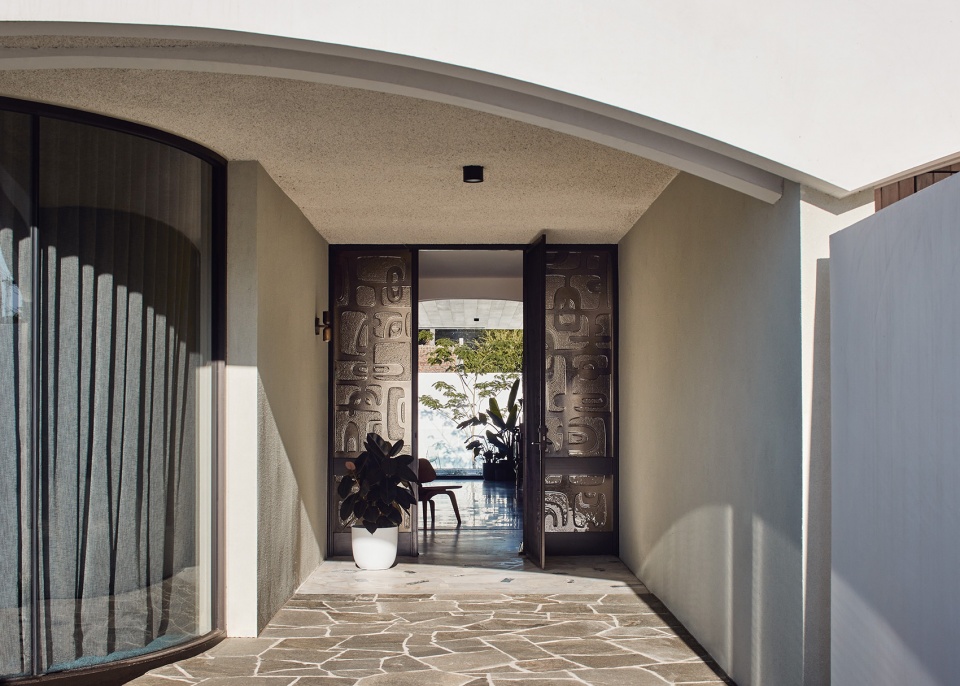

宅院与村庄
Courtyard house and village
项目位于北京市郊一处普通乡村之中。这里属于典型的北方平原村落,以一至二层的院落式住宅作为基本单元构成。房屋大多坐北朝南,红墙红瓦,也可以看到一些随着生活需求变化留下的各类自发性加建形式,有彩钢板顶的,有玻璃顶的各类棚屋,混合存在于乡村自然肌理之中。房主人目前常居于城内,这里将作为家庭度假与朋友聚会的场所。作为村落中一处新的建造,我们希望改造继续呈现出一种新旧混合的状态,与村庄肌理建立关联,低调融入到整个村庄的风貌之中,同时在院内产生一个丰富、自然的小世界。
The project is located in an ordinary village on the outskirts of Beijing, a typical plain-based northern Chinese village mainly composed of one- and two- storey courtyard houses. Most houses in the village face south, and feature red bricks and tiles. Besides, there are also various added constructions built independently by local villagers for meeting their changing living needs, such as shanties with colored-steel roof or glass roof, which blend with the natural fabrics of the village.
▼鸟瞰,Aerial view ©金伟琦
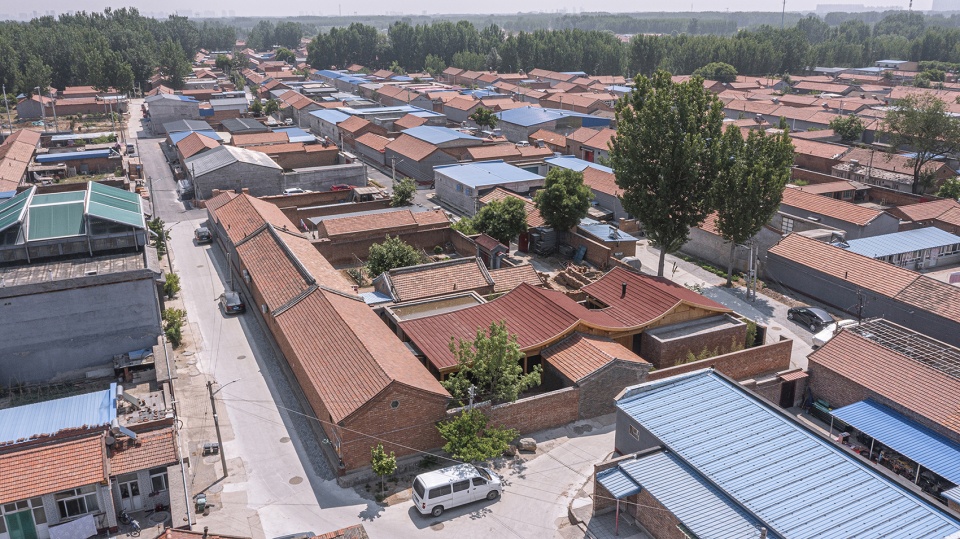
▼顶视图,Aerial top view ©金伟琦
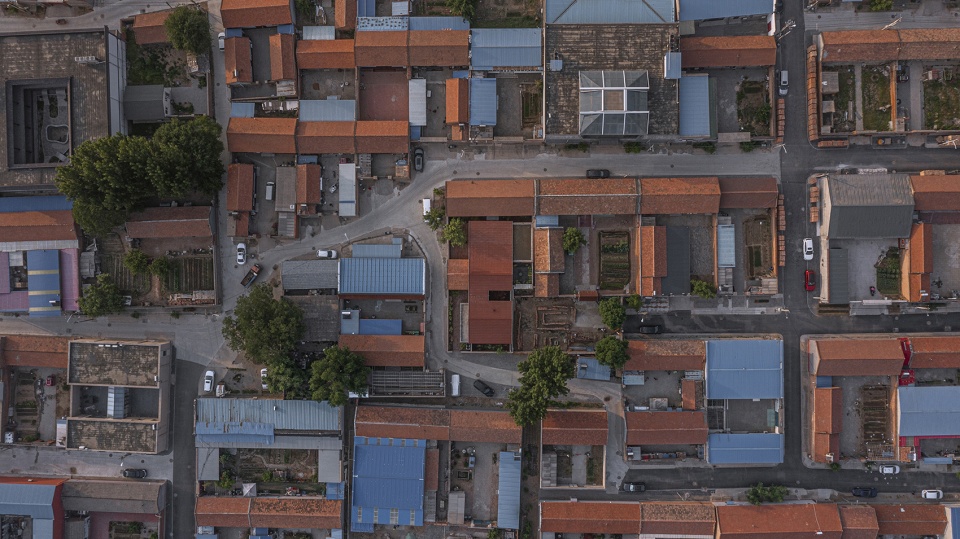
The project is the transformation of a courtyard house in the village. The client, who currently lives in the downtown area, hoped to create a family vacation home and a venue for gathering with friends. As approaching this project, ARCHSTUDIO intended to present an architectural status that mixes the old and new, and to build a connection between the project and the built landscape of the village. The goal was to let the renovated architecture integrate into the village with a low-profile gesture, and meanwhile to create a rich and natural small world inside the courtyard house.
▼总平面图,Site plan © 建筑营设计工作室
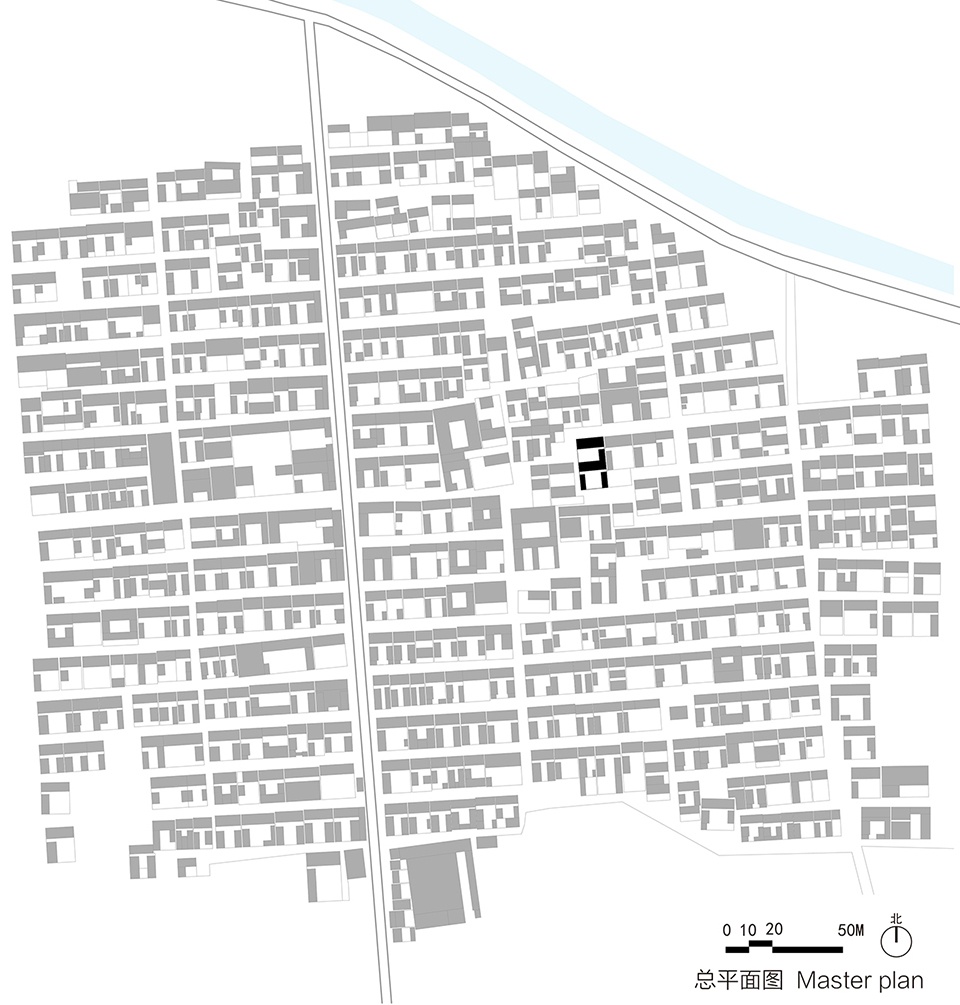
旧房子与新木屋——建筑形式的混合
Old house and new wooden construction
Mix of architectural forms
场地中旧建筑为两进院空间布局,包含两座坡屋顶瓦房和一些平顶房屋。经现场勘察做出基本判断:北房经常被使用且结构质量较好,应予以保留做适当改造;南房结构虽更为老旧,但具有一定的年代价值,可做一定改造后保留;其他附属用房均为临时性搭建,可予以拆除。
The original architecture is a courtyard compound, consisting of two courtyards, two pitched-tile-roof buildings and several flat-roof volumes. After site investigation, the design team decided to retain and properly transform the north building, which were frequently used and were in good structural condition; to renovate and preserve the south building, which had old structures with historical value; and to dismantle other auxiliary volumes built for temporary use.
▼前院(左上)、后院(左下)、立面(右)改造前,Front yard (top left), back yard (bottom left), facade (right) before transformation © 建筑营设计工作室
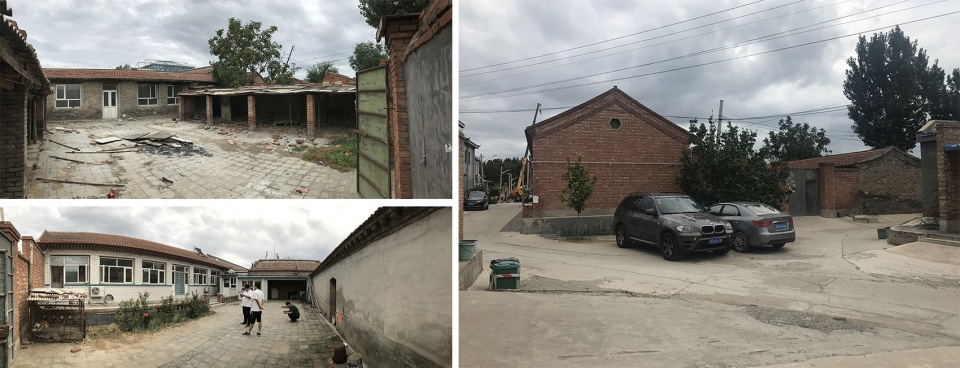
新的建筑体是一座连续起伏的木屋,它覆盖了场地中间的旧屋,并向南北两侧延伸出生活使用空间,构成新的庭院建筑格局。木屋形式随着旧屋坡顶起伏,形成两个连续的屋脊,分别对应着下方的客厅和餐厅、厨房这一家居生活的主要公共空间。木屋的屋檐之下延伸出两块平顶房屋,补充了两间卧室、库房、卫生间等附属功能。北侧的旧屋选择暴露其屋顶结构并在室内划分出两个卧室和起居空间。木屋的介入加强了屋顶起伏的层次变化,并形成了建筑体量层面上的新旧混合关系。
▼空间分析,Spatial analysis diagram © 建筑营设计工作室
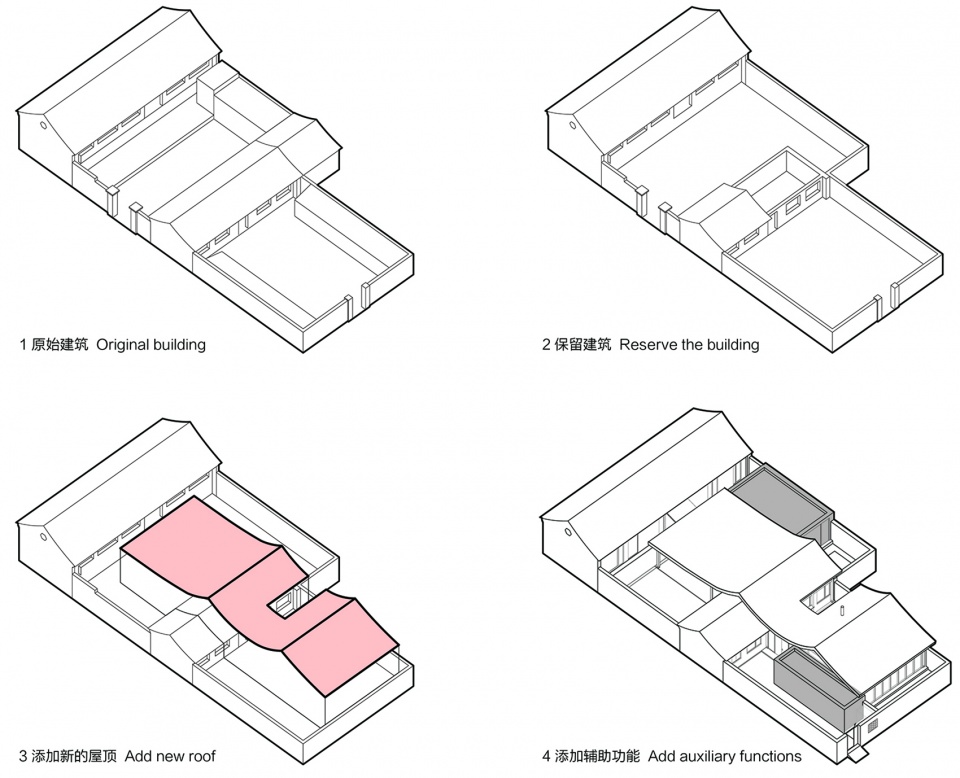
▼结构图解,Structural diagram © 建筑营设计工作室
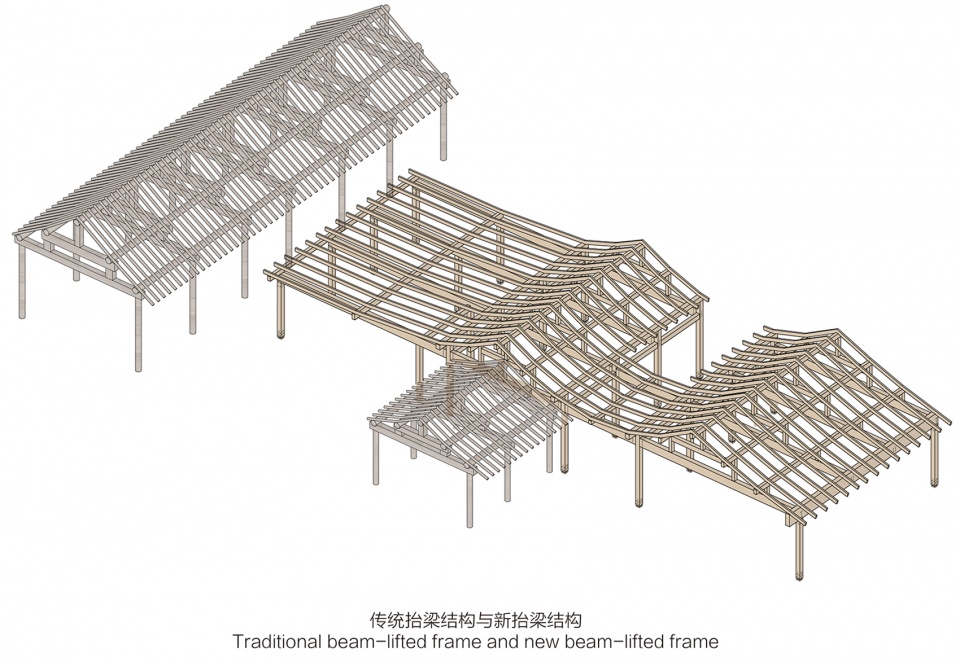
The new addition is an undulating wooden construction, which replaces the old rooms at the middle of the site and extends to north and south sides to create spaces for daily life use, hence shaping a new pattern for the courtyard compound. The new wooden volume undulates in line with the old roofs, and forms two continuous roof ridges, under which are major public living spaces including living room, dining room and kitchen. In addition, two flat-roof building blocks are extended under the roof of the wooden construction, accommodating ancillary functions including two bedrooms, garage and bathroom. For the old building on the north side, the design team exposed its roof structures, and set two bedrooms and a living room in its interior space. The insertion of the new wooden construction strengthens the undulating layering of the roofs, and creates a dialogue between the old and new building volumes.
▼正立面,Front facade ©金伟琦
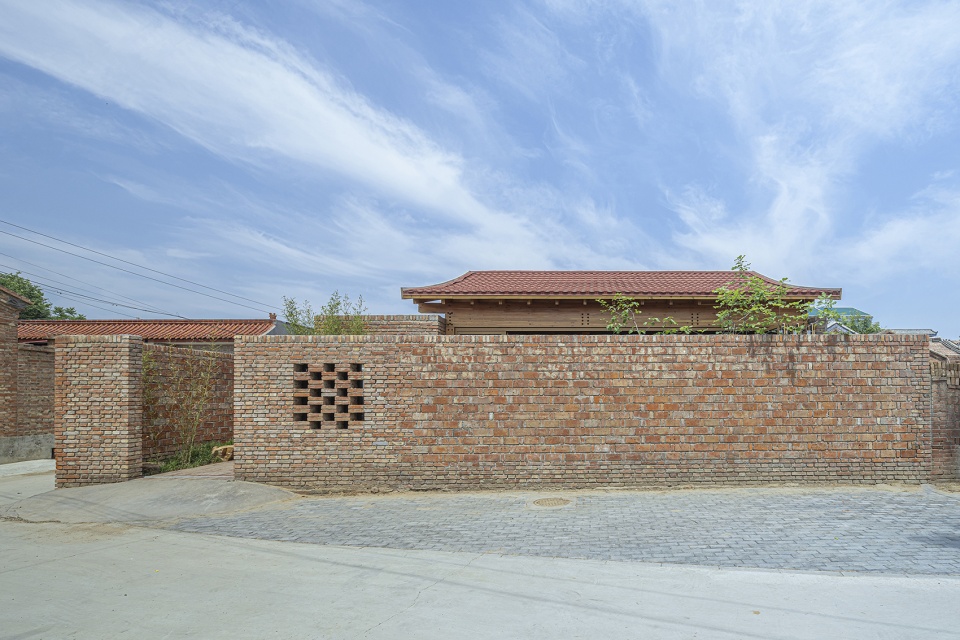
▼侧立面,Side facade ©金伟琦
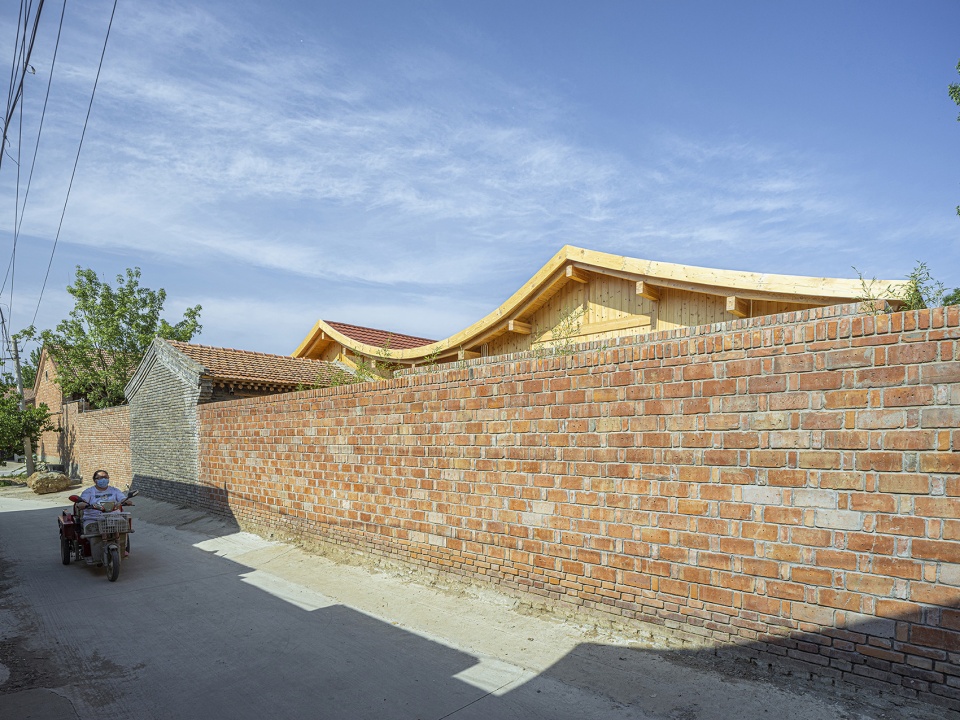
庭院与室内——行为活动的混合
Courtyard and interior
Mix of behaviors
原本的二进院的庭院格局被打散,形成六个尺度、景观、功能各不相同的庭院。前院设置在场地西南角,拉开金属大门,竹林小径将人引向房子的入口。推门而入,门厅正对着一个小院,一株姿态较好的红枫映入眼帘,在不同季节展示着自然的色彩,成为客厅与餐厅之间的点景。客厅与南侧院墙留出侧院,院中植树置石,天气晴好时,客厅折叠门可以完全展开,含院入室内。
▼庭院图解,Courtyard diagram © 建筑营设计工作室
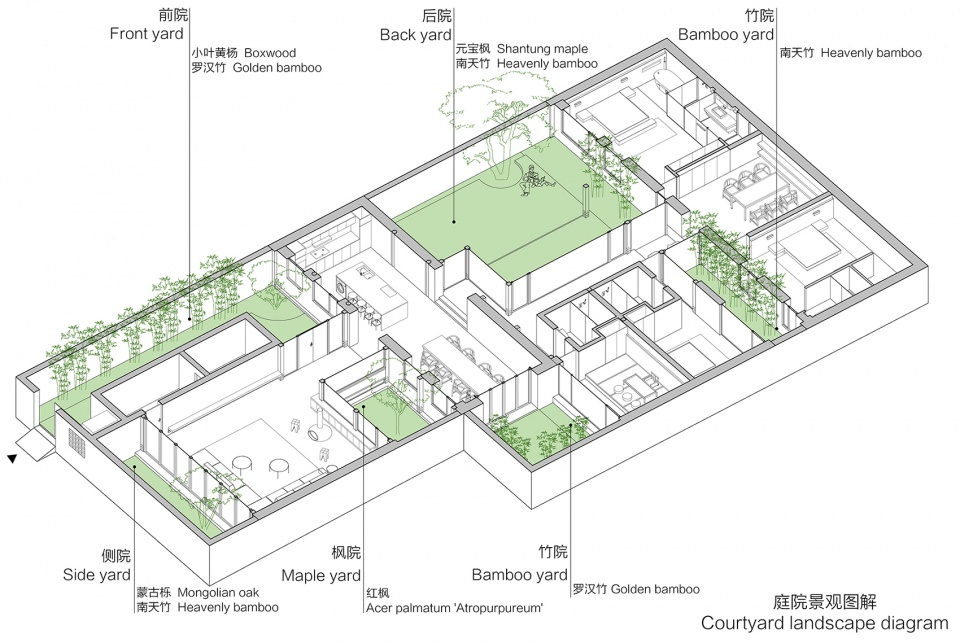
▼前院,Front yard ©金伟琦

The original spatial pattern featuring one front yard and one back yard are reorganized, to form six yards with different scales, landscapes and functions. The front yard is set at the southwest core of the site. Opening the metal gate, a bamboo path leads the occupants to the building entrance. Pushing the door and entering the foyer, a courtyard with a maple tree comes into view. The maple tree displays the colors of nature in different seasons, and becomes a highlighted view between the living room and the dining room. Space set aside between the living room and the south enclosure wall forms a side yard, where trees and stones are set. In sunny days, the folding doors of the living room can be completely opened, to extend the yard into the interior.
▼门厅,Foyer ©金伟琦
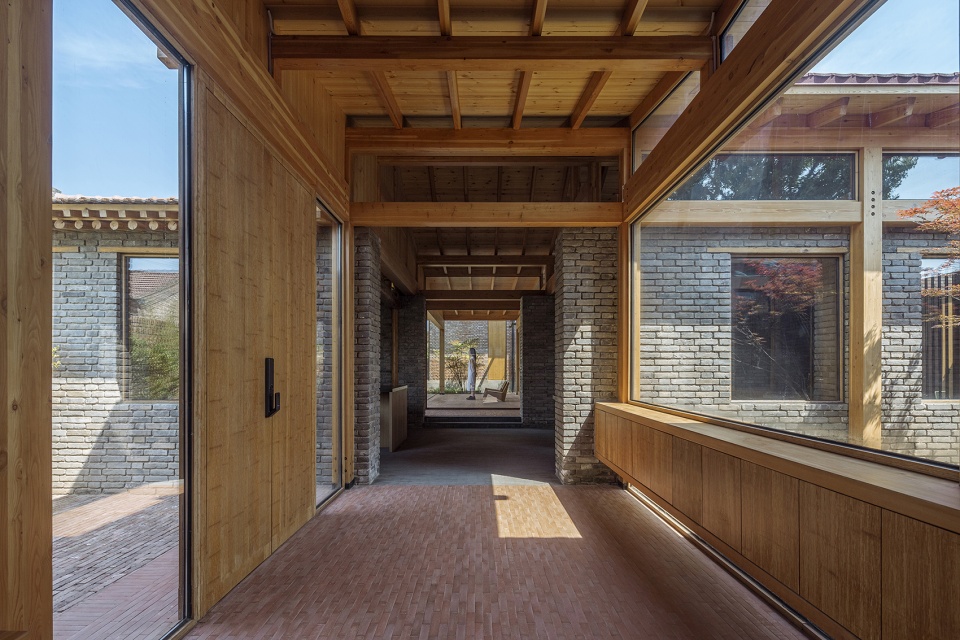
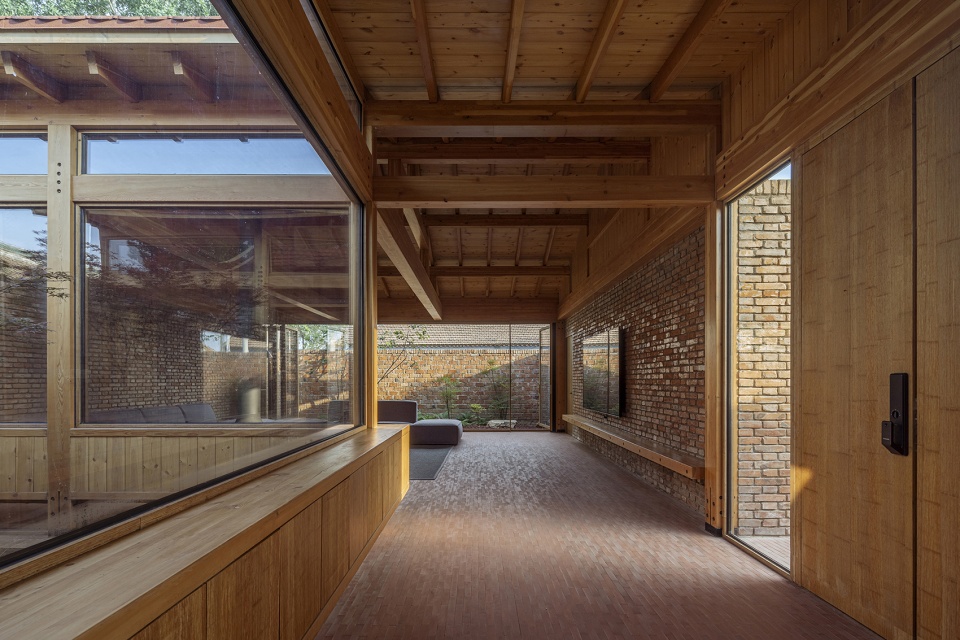
▼由门厅看入户庭院,Viewing the entrance courtyard from the foyer ©金伟琦
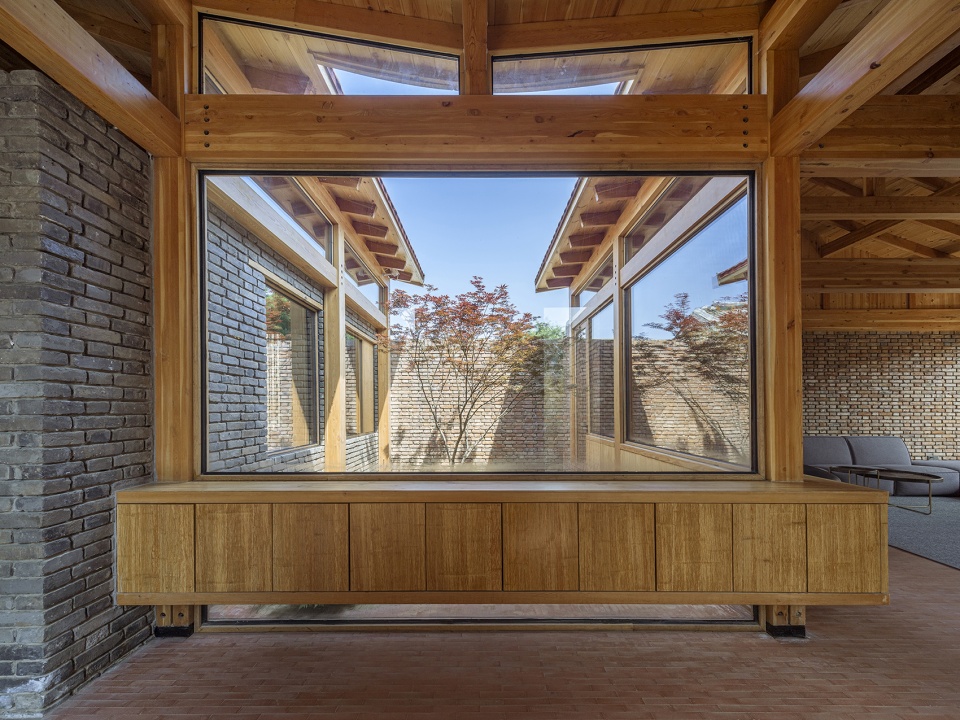
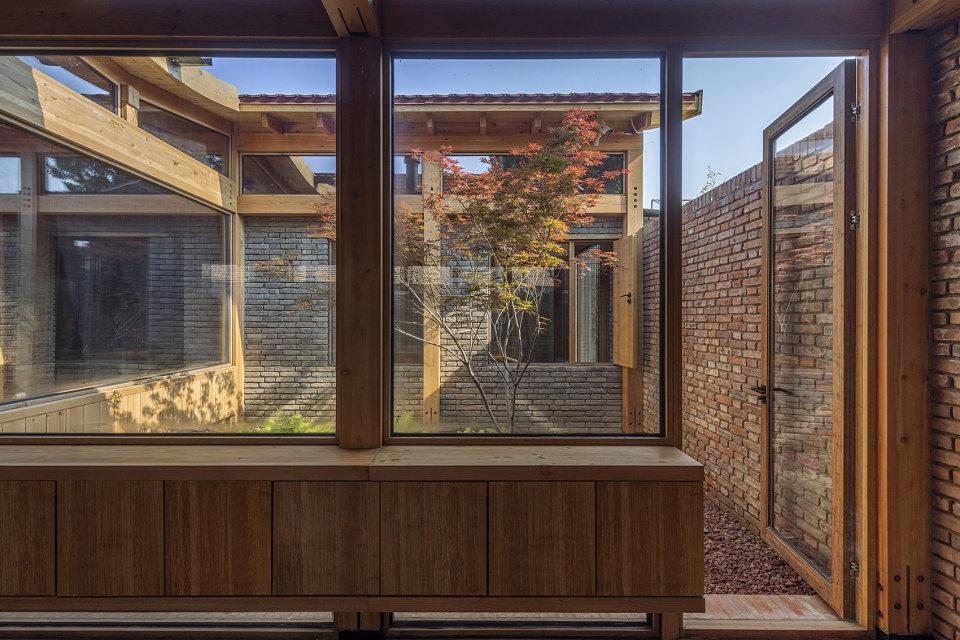
向北进入旧屋,餐厅、厨房一字排开,旧木屋顶与新木构屋顶相互对照。餐厅向外与邻居家院墙形成一处竹林庭院,就餐活动可延伸到庭院中,置身于竹林中饮食品茶。
▼客厅,Living room ©金伟琦
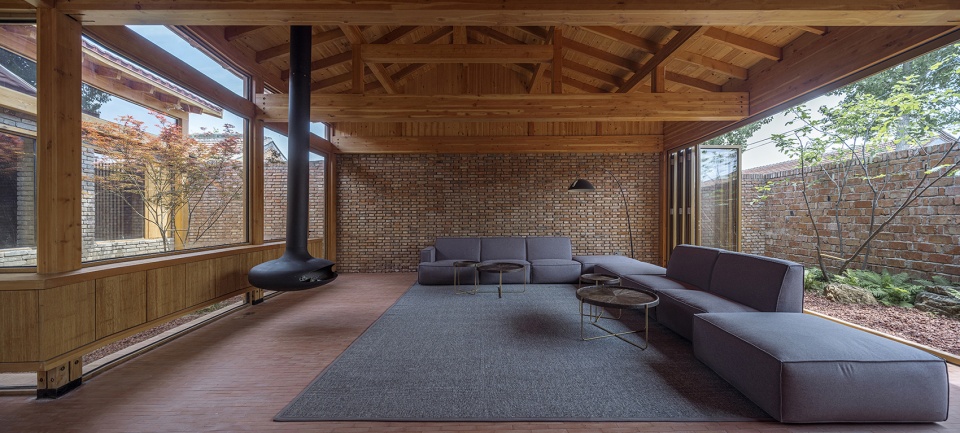
▼由客厅看庭院,Viewing the courtyard from the living room ©金伟琦
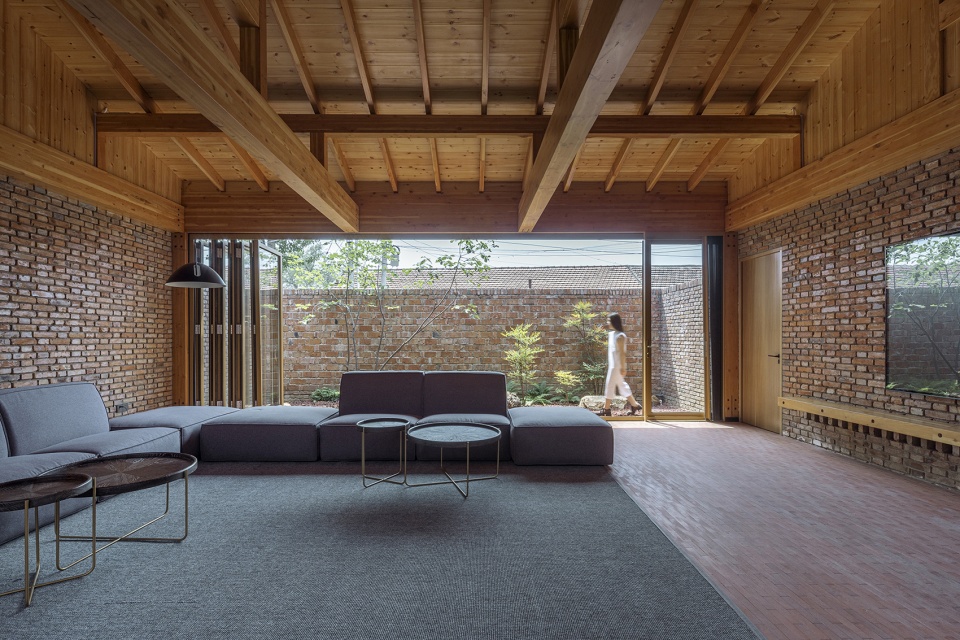
▼由客厅看走廊,Viewing the veranda from the living room ©金伟琦

Further moving towards the north, the occupants will reach the renovated old building. Here, the kitchen and the dining room unfold horizontally, and the old and new roof structures dialogue with each other. Between the dining room and the walls of a neighbor’s house is a bamboo yard, which offers an experience of eating and drinking in a bamboo grove.
▼餐厅,Dining room ©金伟琦
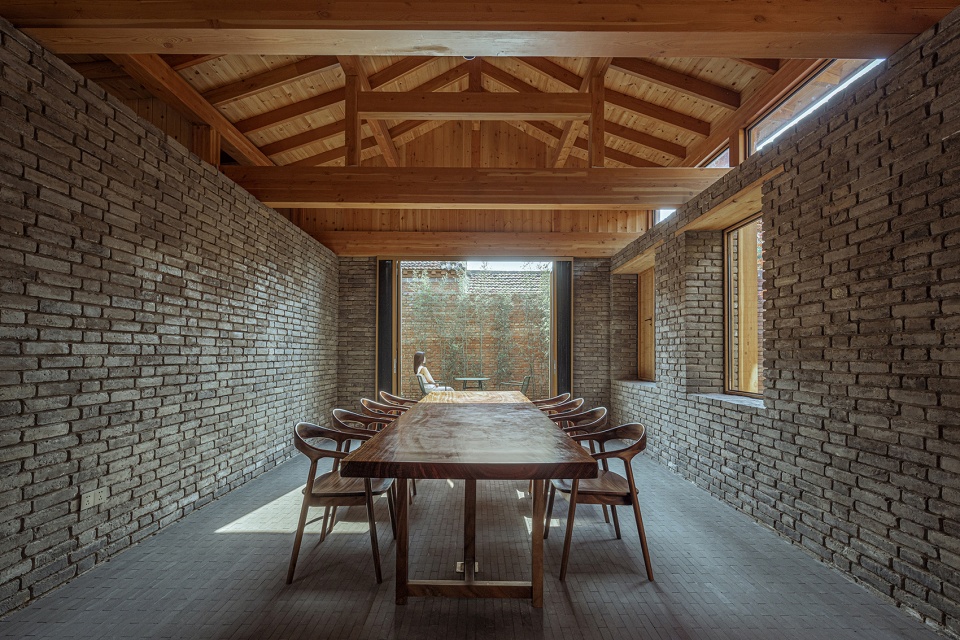
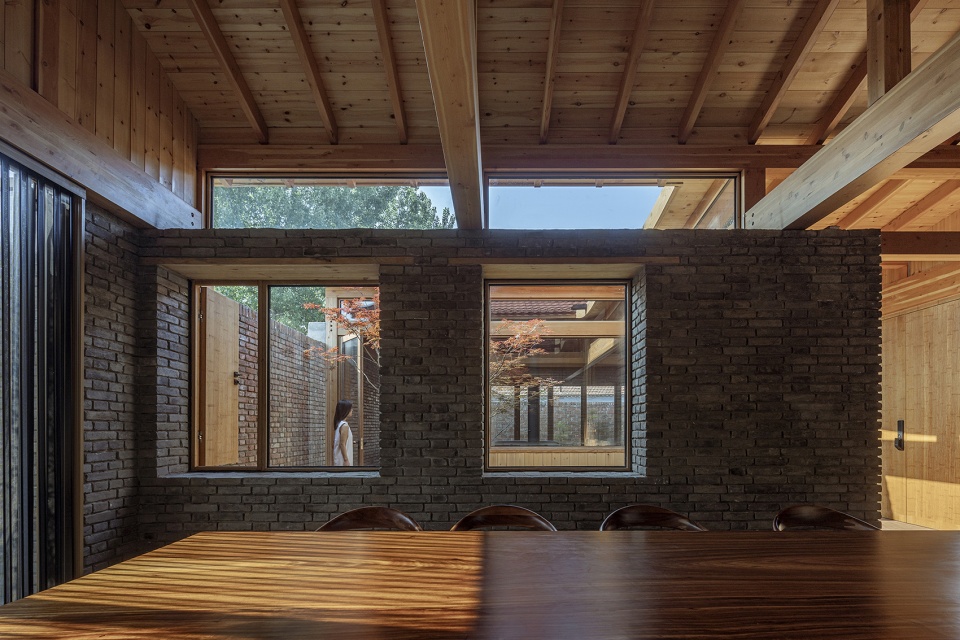
▼厨房,Kitchen ©金伟琦
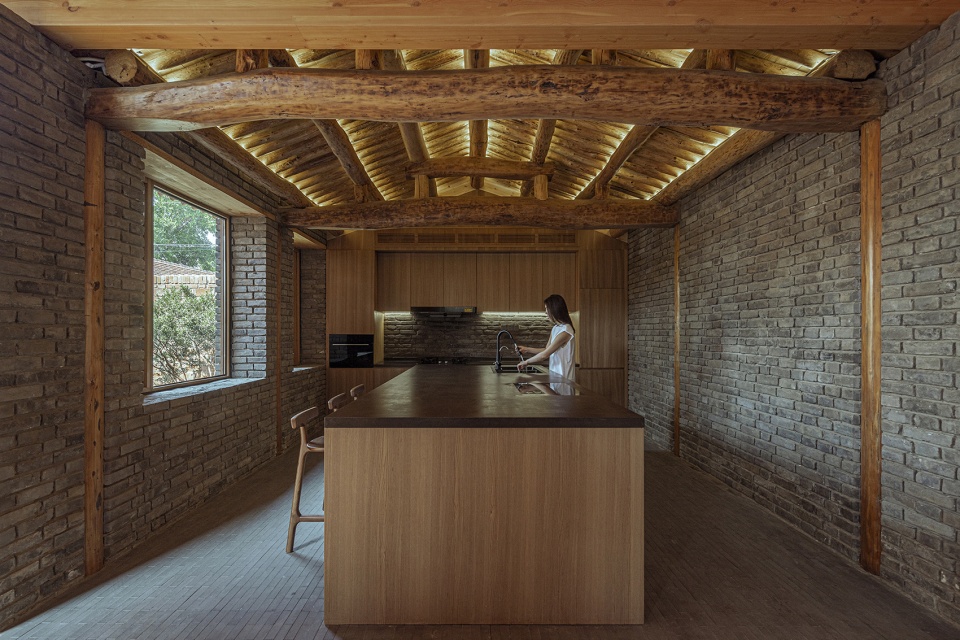
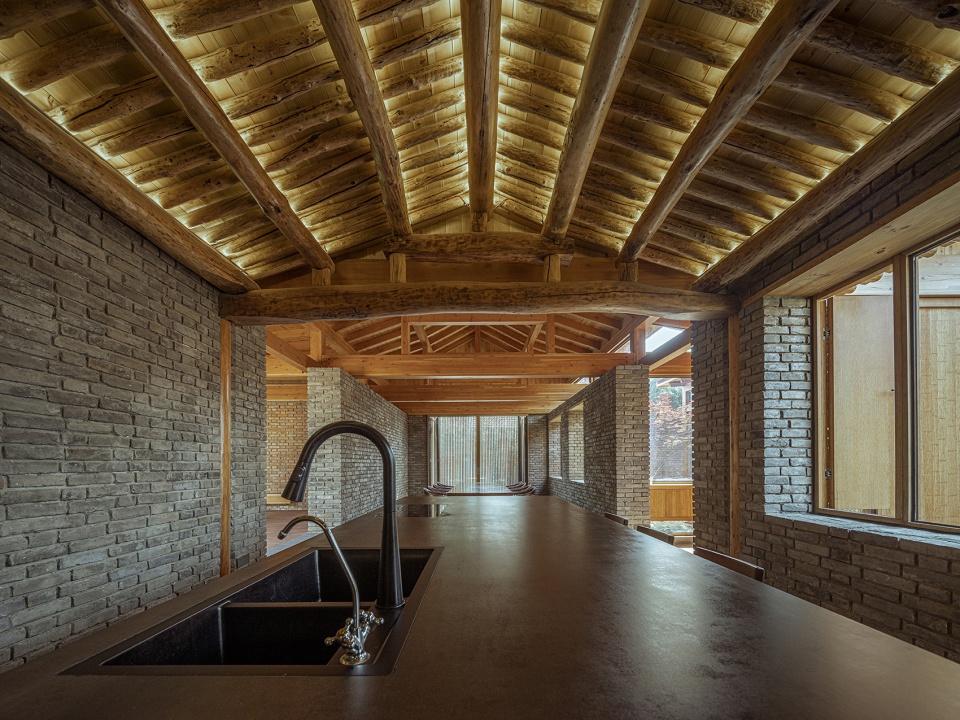
▼茶室,Tea room ©金伟琦
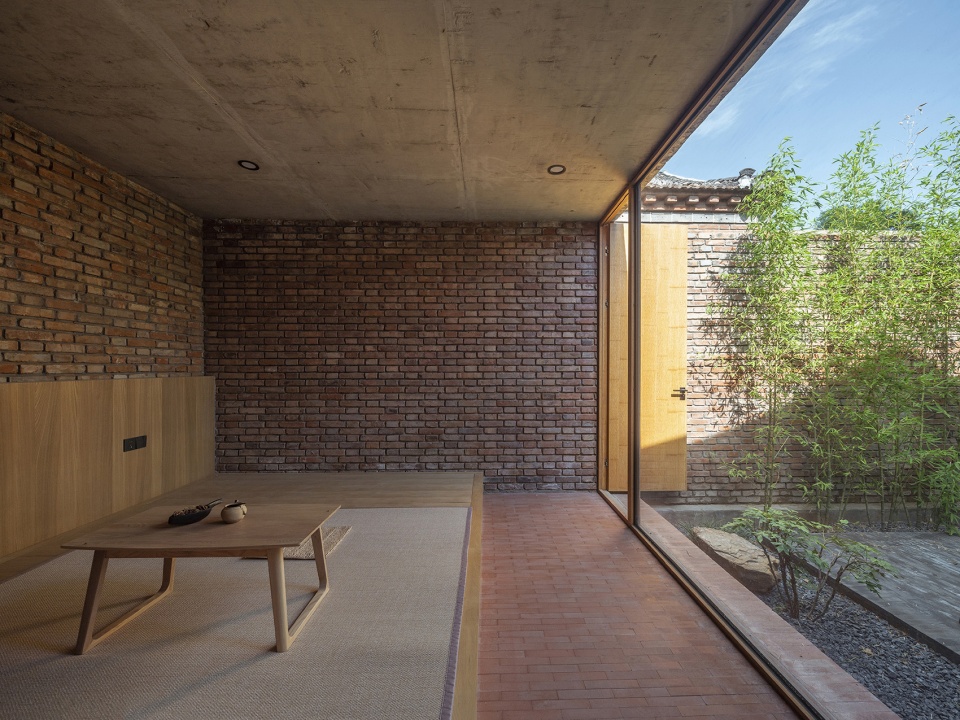
通过餐厅即进入后院,此院为主要室外活动院落,通过半室外走廊过渡到庭院当中,院中植有大树。可在外廊中小憩,也可在大树下聊天。
After passing through the dining room, the back yard is reached. This yard is mainly for outdoor activities, and is connected with a semi-outdoor veranda. Planted with a big tree, it provides a pleasing place for leisure and chatting.
▼半室外走廊,semi-outdoor veranda ©金伟琦

▼由半室外走廊看后院,Viewing the back yard from the veranda ©金伟琦
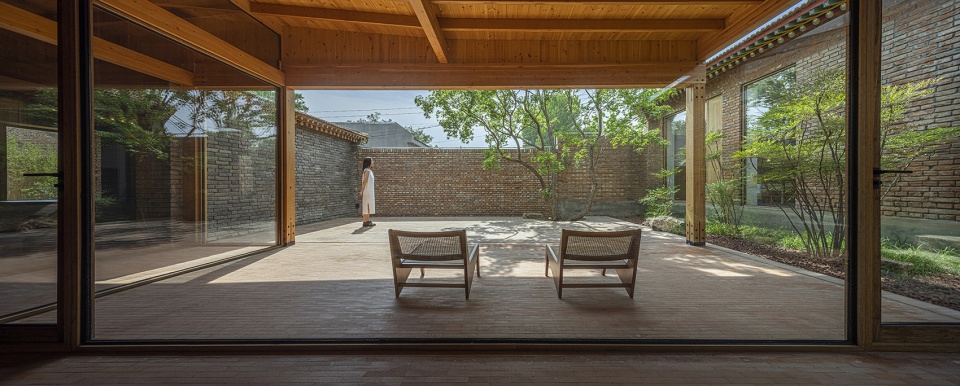
▼模糊的室内外界限,Blurred indoor-exterior boundaries ©金伟琦
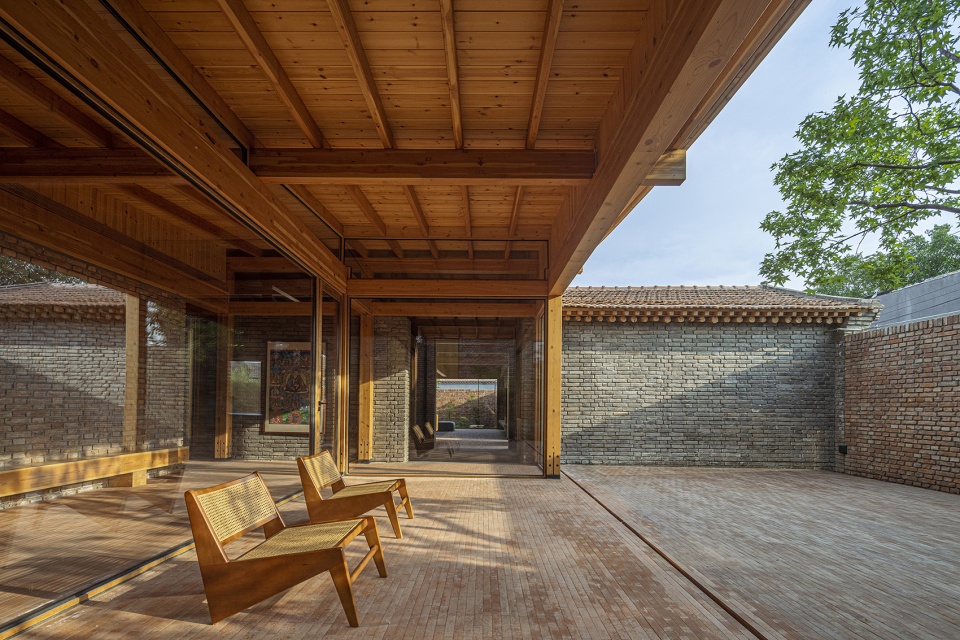
▼由后院看建筑,Views from the backyard ©金伟琦
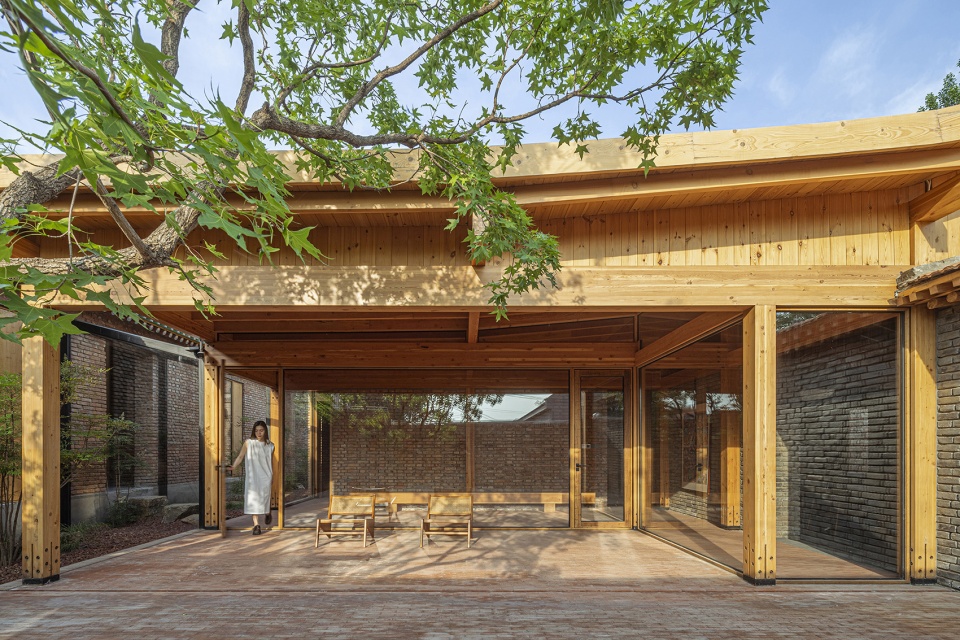
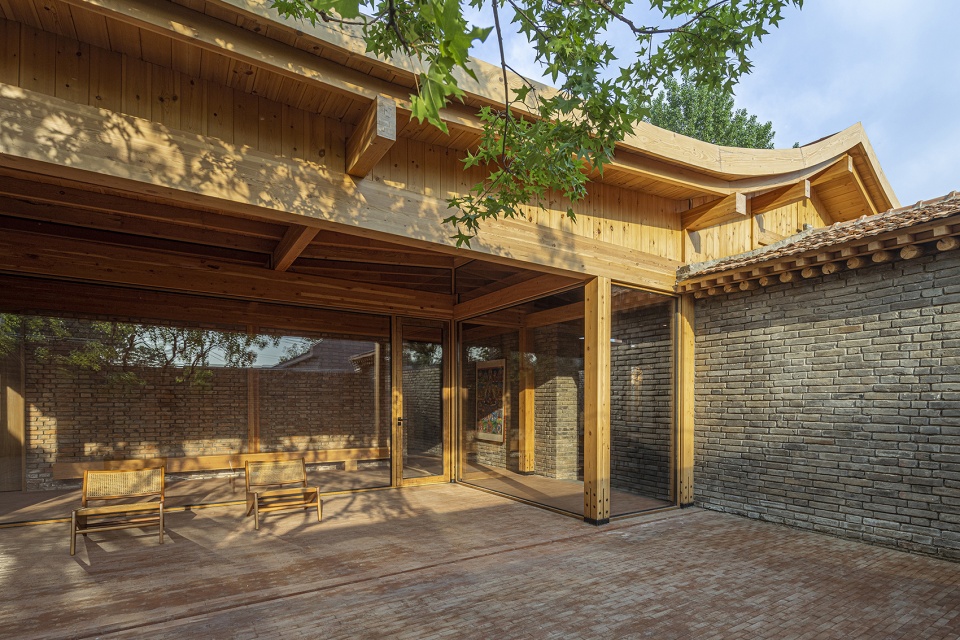
继续向后进入卧室区,北房与木屋之间通过玻璃廊相连,自然区隔出一个窄院。三个卧室均可直接面向室外景观,满足采光通风需求,同时视线避免干扰。不同庭院的设置,让室内各个角落都焕发着自然的生机。
The space at the back is the bedroom area. The north building and the wooden construction are connected by a glass corridor, which naturally forms a narrow yard. The three bedrooms provide a direct view to the outdoor landscape, satisfy daylighting and ventilation needs, and meanwhile avoid obstructed sight lines. The organization of various yards brings natural vitality into every corner of the interior space.
▼主卧,Master bedroom ©金伟琦
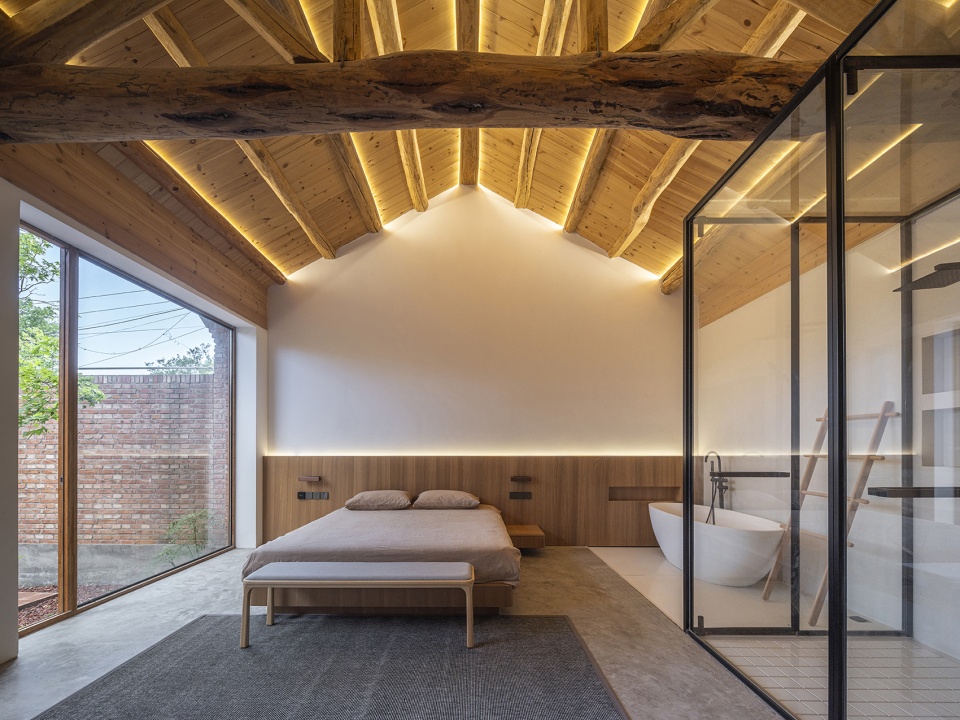

▼次卧,Secondary bedroom ©金伟琦
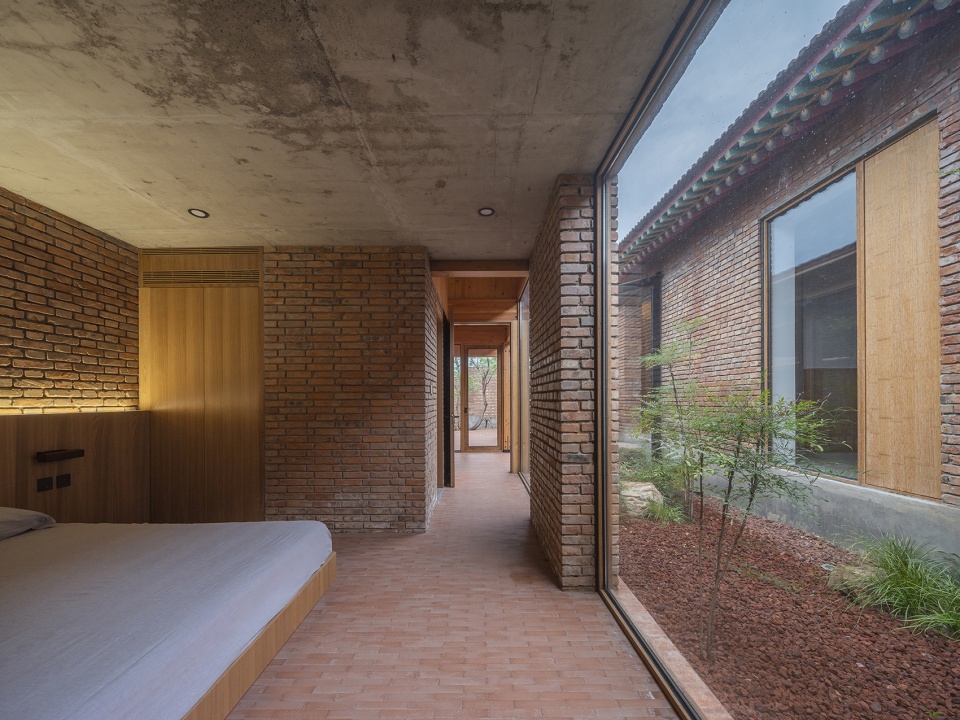
结构与材料——新与旧的混合
Structures and materials
Mix of the old and the new
新木屋采用雪松胶合木作为主要材料,结构形式上借鉴抬梁式架构,回应北方民居的木作传统。充分利用胶合木这一低碳、可再生的自然建材,用新的结构表现接续旧屋的木构,实现新与旧在结构层面上的对话。以尽量小的梁柱截面和尽量大的跨度实现连续起伏的屋顶,保证结构合理的同时控制造价成本。
The newly built wooden construction adopts cedar plywood as main material and applies traditional beam-lifted frames, to echo the features of traditional northern Chinese houses. By fully utilizing plywood, a low-carbon and renewable natural building material, the newly inserted wooden construction continues the existing old house’s wooden frame with new structural expressions, hence creating a dialogue between the old and the new. Moreover, the undulating new roof is constructed with beams and columns featuring minimized cross sections and maximized spans, to ensure a reasonable structure and control costs.
▼新与旧在结构层面上的对话,Dialogue between the old and the new ©金伟琦
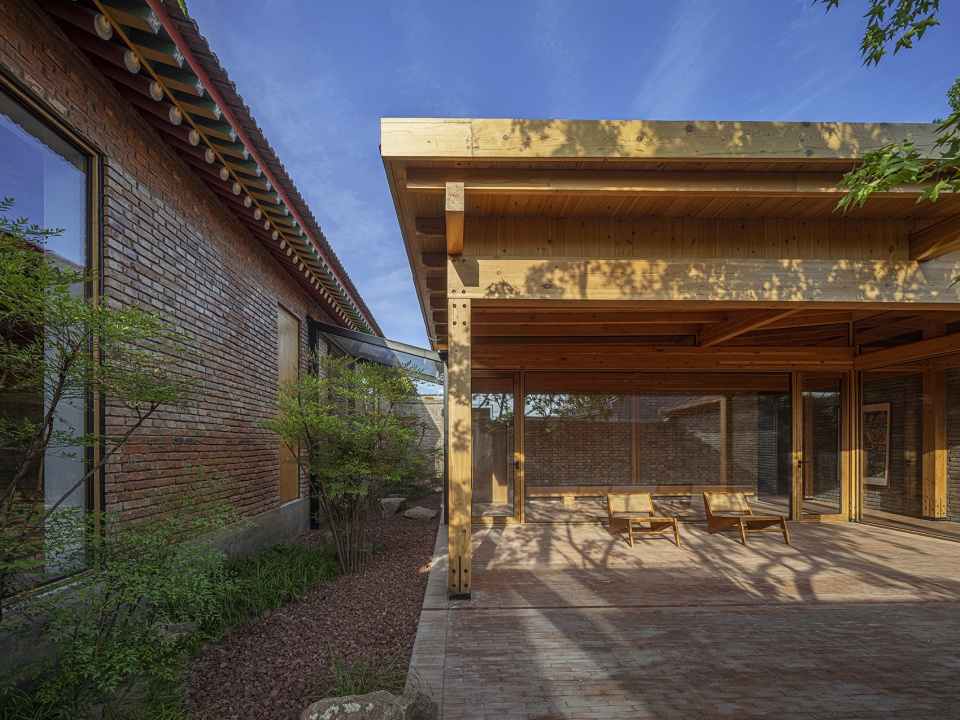
▼走廊,Veranda ©金伟琦
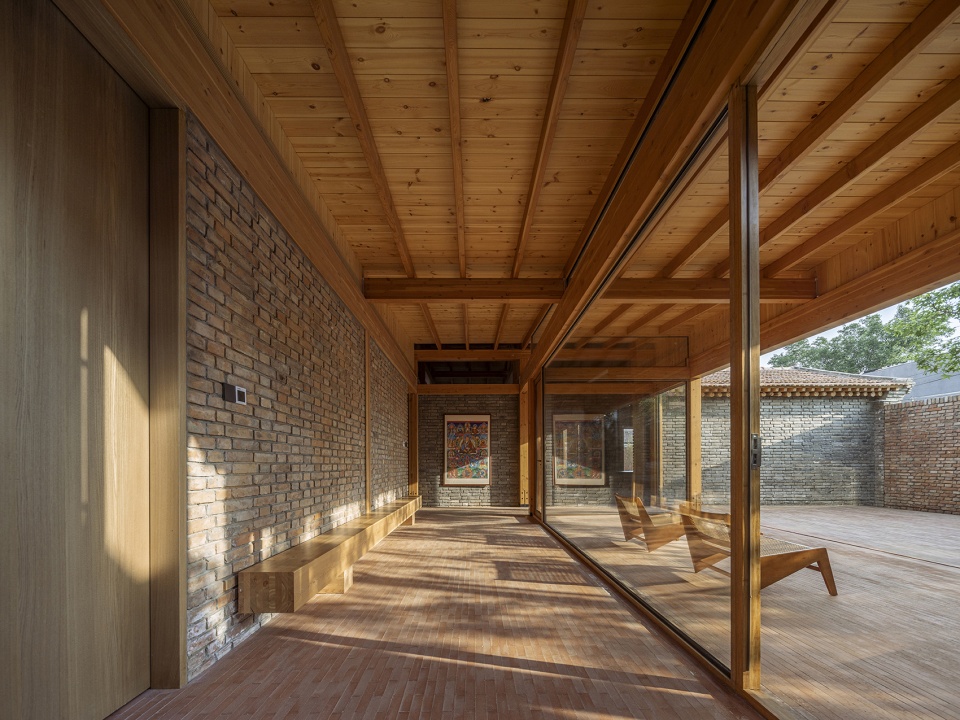
新建围护墙体全部采用当地回收的旧红砖和青砖砌筑而成,也实现了废旧材料的循环再利用。旧房修缮的环节中,保留下来的北房外墙为白色瓷砖,现场决定剔除打磨,露出原来基层的红砖墙面。南屋局部屋顶在拆除过程中发现原有结构破损严重,墙体也有倒塌的风险,因此落架重修,替换部分木构件,墙体用旧青砖按原建筑形式重新砌筑。门窗采用固定中空玻璃与竹钢板材可开启扇结合。实体开启扇可以满足通风需求,而固定玻璃窗保持取景的完整性。室内固定家具也全部由竹钢板材定制而成。胶合木、竹钢和旧的木梁形成了木料间的新旧混合关系。
The newly built enclosure walls are completely made of red and gray old bricks recycled locally, which realizes the reuse of waste materials. When renovating the existing buildings, the design team decided to remove and polish the white ceramic tiles on the exterior of the preserved north building to expose its red-brick walls. As demolishing parts of the south building’s roof, the designers found that its original structures were seriously damaged and the walls under it were at the risk of collapse. Therefore, they took the roof apart, and replaced some old wooden components with new ones. Meanwhile, the walls were rebuilt with old gray bricks in consistent with their original forms. Doors and windows employ fixed insulating glass and openable frames made of laminated bamboo panels. The solid openable window frames help improve ventilation, and the fixed glass panes provide complete outdoor views. Besides, all indoor fixed furniture pieces are customized with the use of laminated bamboo panels. Various timer materials, including plywood, laminated bamboo and the existing wooden beams, form a fusion of the old and the new.
▼夜景鸟瞰,aerial night view ©金伟琦
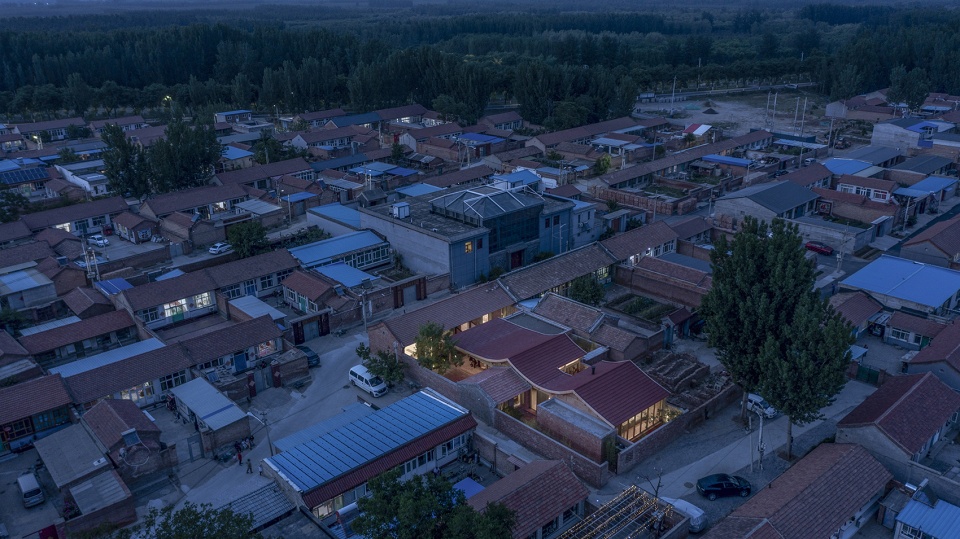
▼主入口夜景,Main entrance ©金伟琦
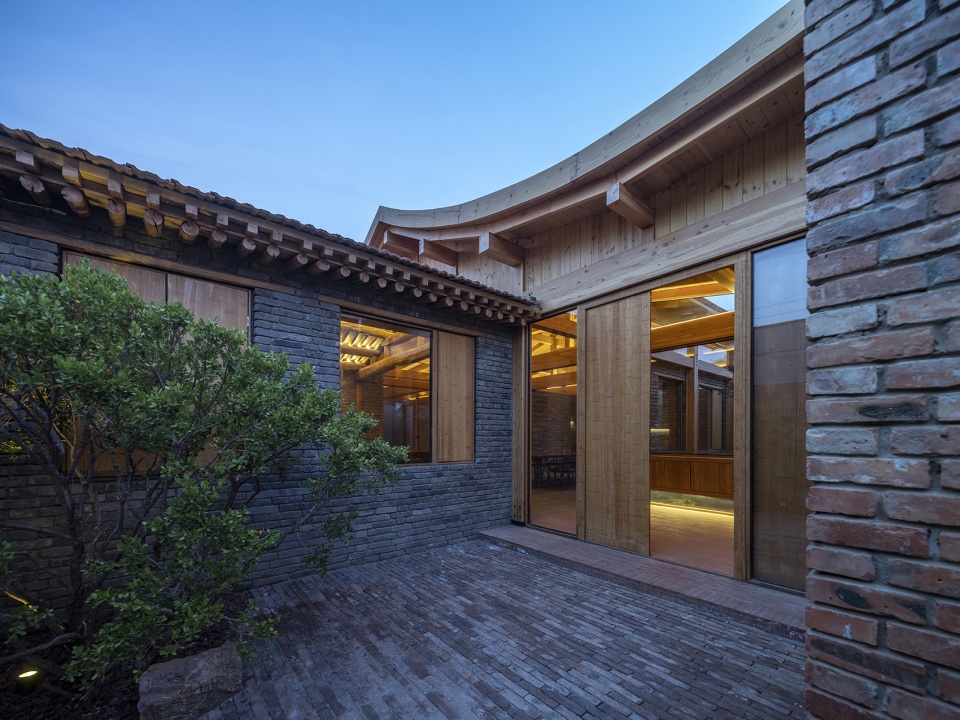
地面铺装则采用购置的新的红砖铺就,具有更好的防水防尘的效果。屋面采用金属蛭石瓦,取其荷载轻、寿命长、造价低。金属瓦的红色表面与村庄内常见的红色板瓦相互混合。院落的营造、结构的更新、材料的再利用,设计试图创造一种新旧迭代演进的可持续设计策略,在个性特征、风貌协调、造价控制之间建立平衡,为乡村建筑更新提供新的可能性。
The ground is paved with new red bricks, which perform better in resisting water and dust. Rooftops are clad in red vermiculite-coated metal tiles, which are lightweight, cost-saving and have a long life span. The red surfaces of those metal tiles harmonize with the red roofing tiles commonly seem in the village. By creating yards, updating structures and reusing materials, the design team tried to invent a sustainable design strategy for the evolution from the old to the new. Besides, they struck a balance in maintaining characteristics, coordinating styles and controlling costs to create new possibilities for the renewal of rural architecture.
▼客厅夜景,Living room ©金伟琦
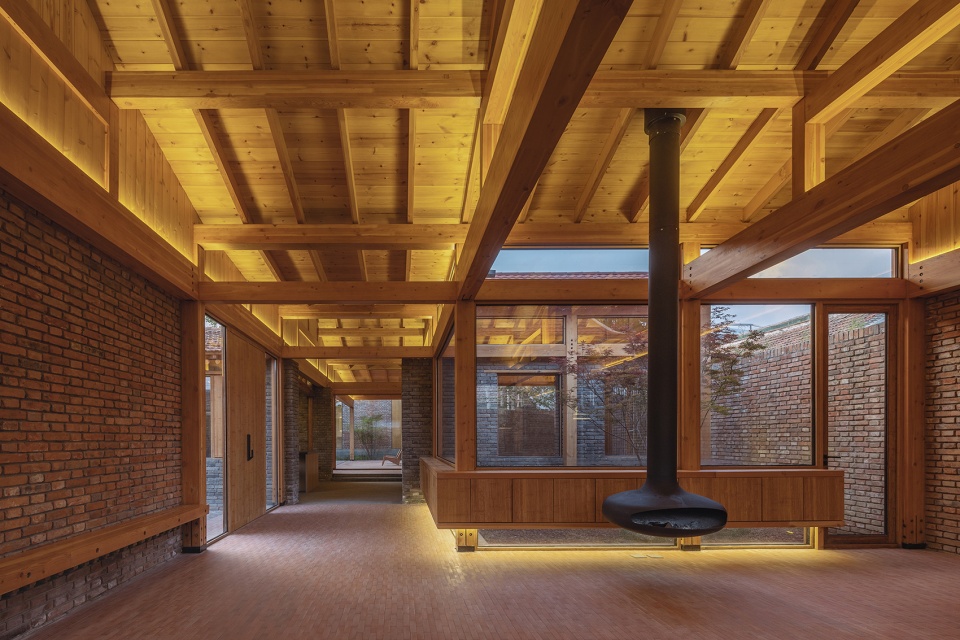
▼半室外走廊夜景,night view of the semi-door veranda ©金伟琦
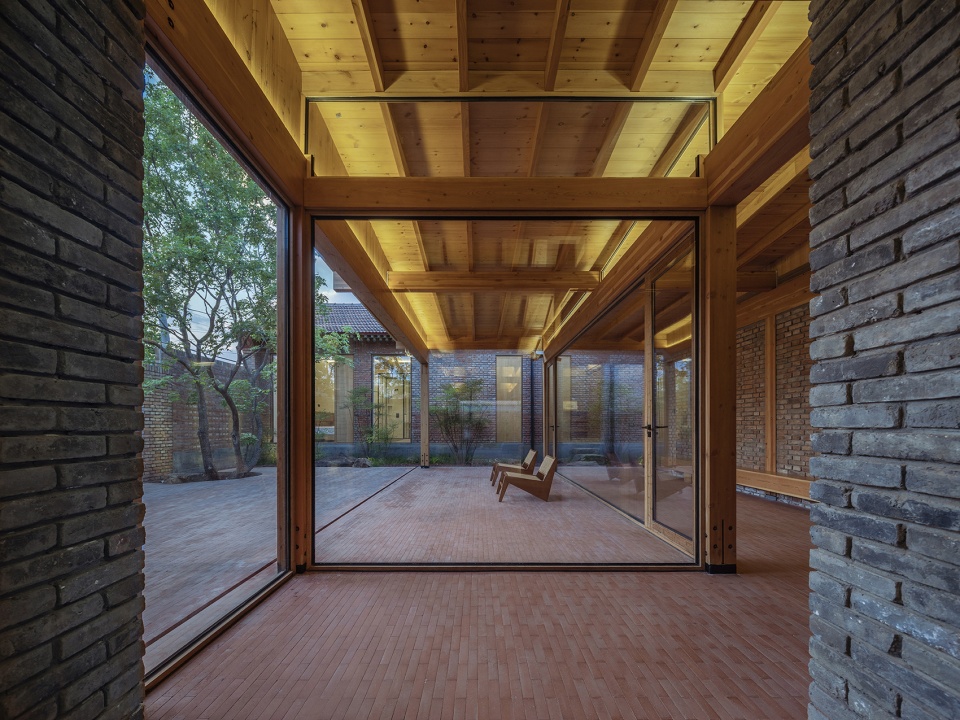
▼施工过程,under construction © 建筑营设计工作室
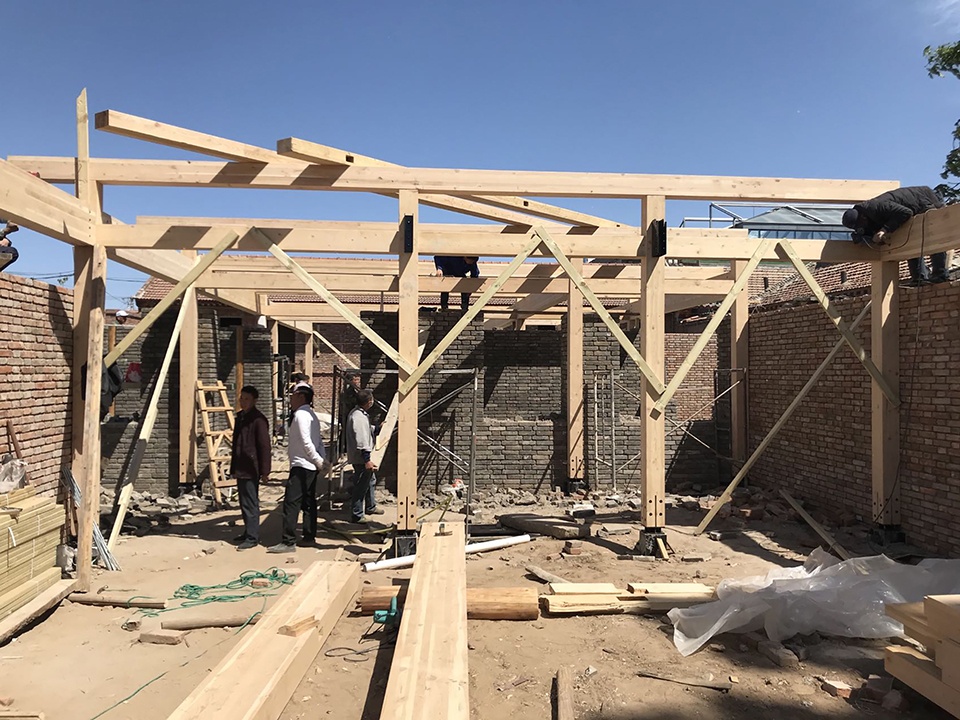
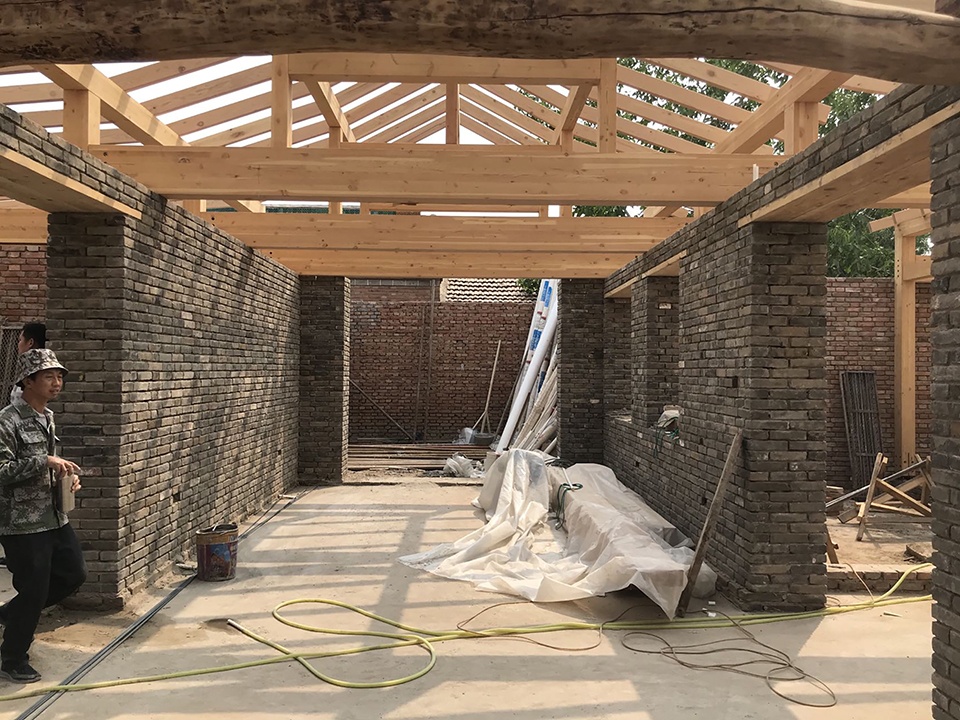
▼工作模型,Model © 建筑营设计工作室
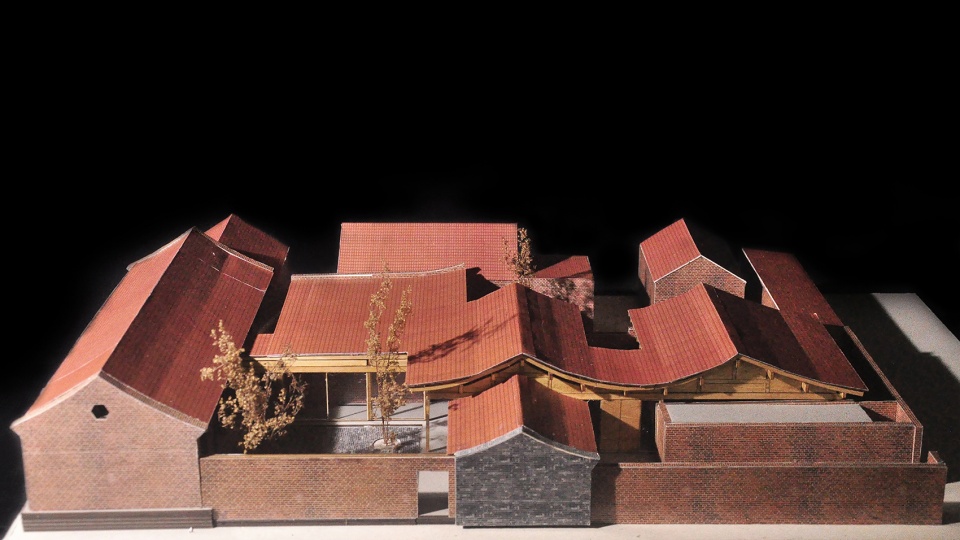
▼屋顶平面图,Roof plan © 建筑营设计工作室
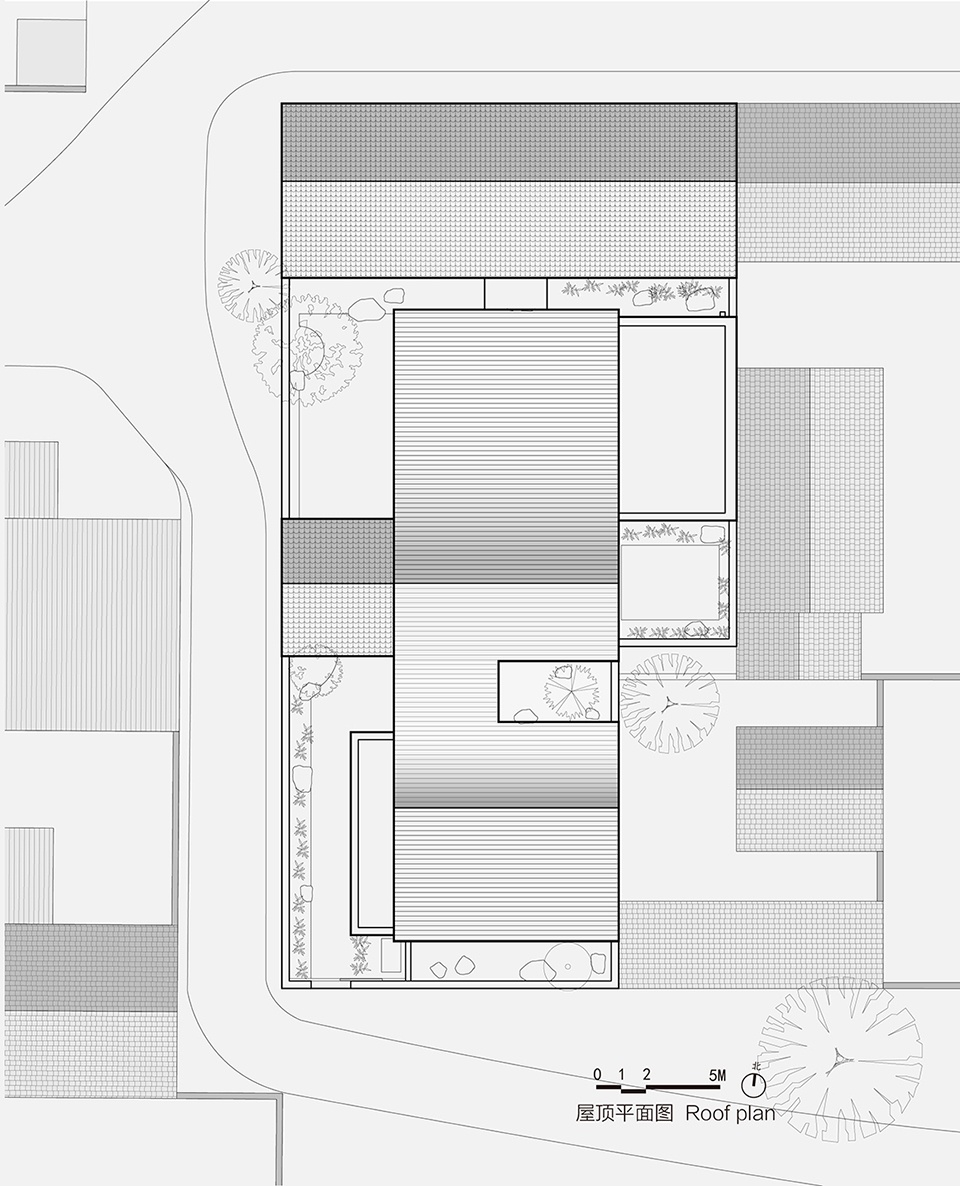
▼平面图,Floor plan © 建筑营设计工作室
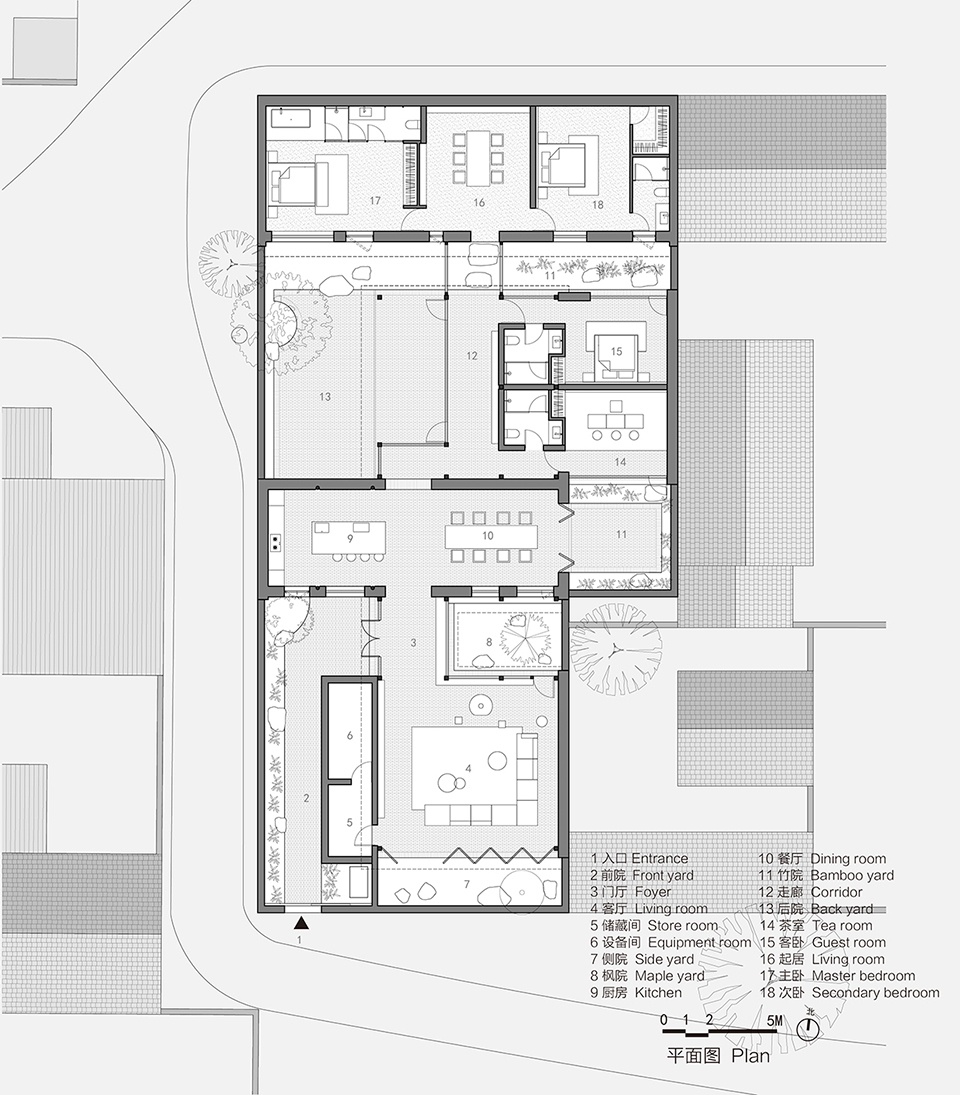
▼立面图,Elevations © 建筑营设计工作室
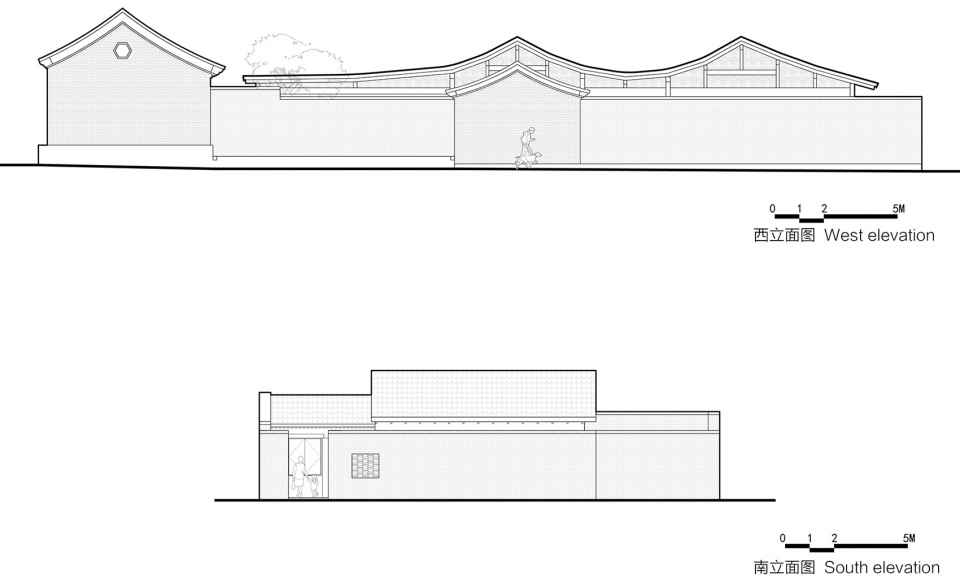
▼剖面图,Sections © 建筑营设计工作室
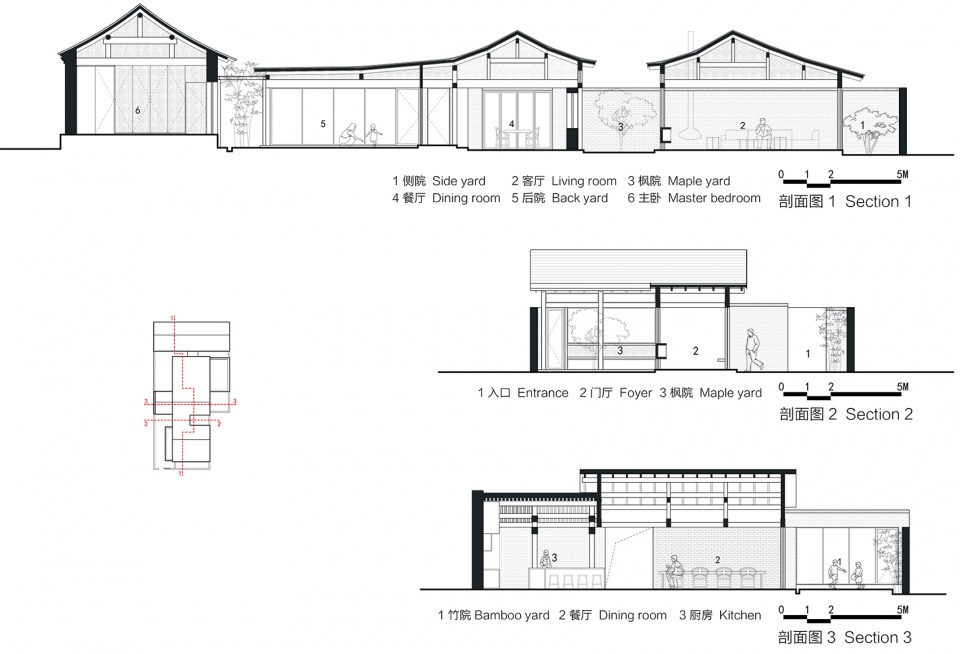
▼细部详图,Construction details © 建筑营设计工作室
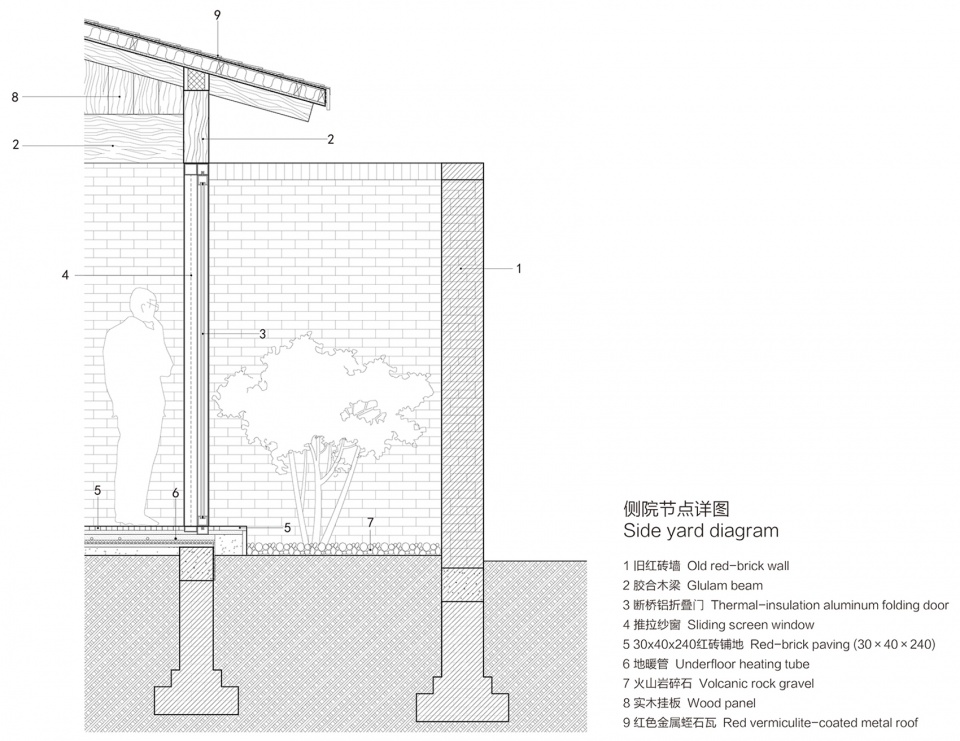
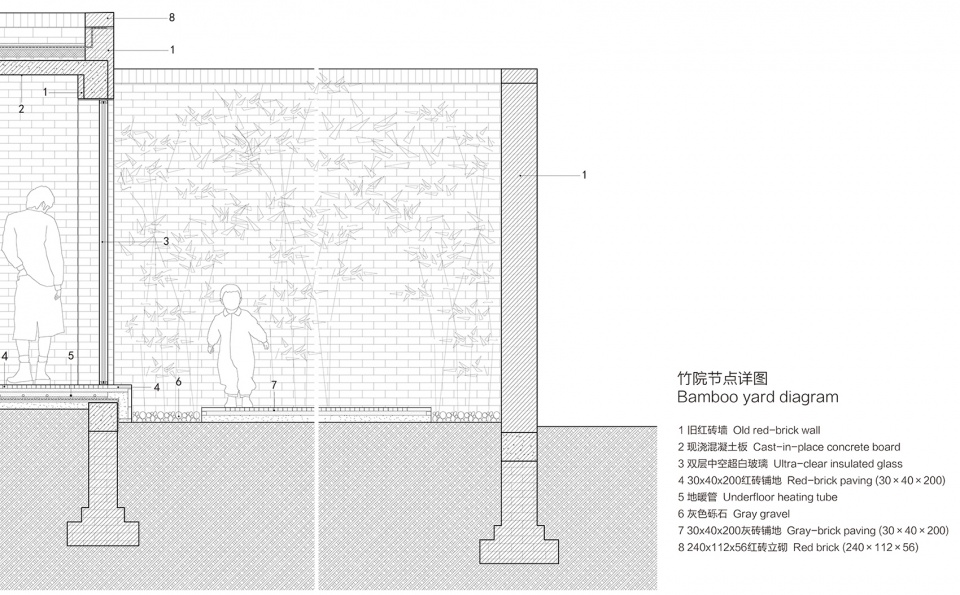
项目信息
项目名称:混合宅
项目位置:北京市通州区石小路
设计公司:建筑营设计工作室
主设计师:韩文强、李晓明
项目设计师:郭建刚、孟罡宇(实习)
结构咨询:北京欣南森木结构工程有限公司
机电咨询:郑宝伟、李东杰、张英男
景观咨询:荒野造景
施工团队:北京欣南森木结构工程有限公司
占地面积:576㎡
建筑面积:373㎡
建筑高度:5m
设计时间:2020.10—2021.04
施工时间:2021.04—2022.04
主要材料:胶合木、砖、竹钢
项目摄影:金伟琦












